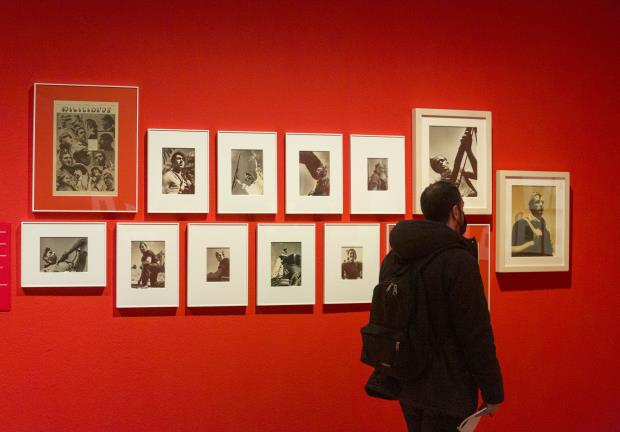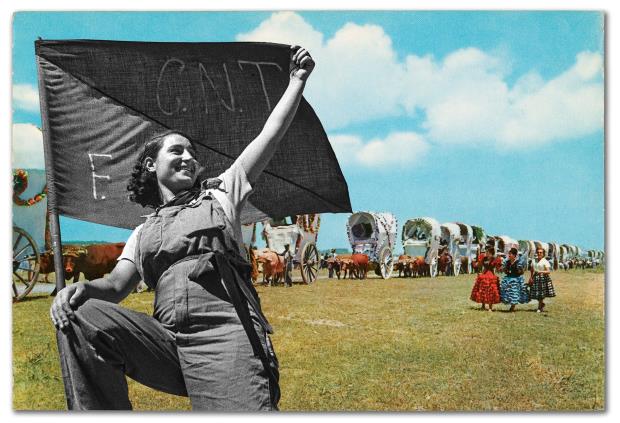Jesús Galdón


1001 postcards from nowhere. Artistic installation by Jesús Galdón, 2021. Postcards of A. Campañà and J. A. Puig Farran (CYP) from the years 1960-1970 intervened with images of militiamen by A. Campañà from 1936-1938
Campañà is always a gaze in action. In this way, as in this quote, he mentions the responsibility of showing the beauty of all that is resolved by the divine hand, we could establish a certain analogy in relation to the divine gaze in the sense of the gaze which sees everything, which photographs everything. Nothing is better or worse than being able to be captured by the eye of the lens, always attentive and considering the pursuit of beauty as a duty, as an inalienable responsibility.
“I consider myself obliged to produce photographs with original points of view and I believe it is my duty to show the world a nature all well resolved by the divine hand.”
Antoni Campañà, around 1965
The naive and clean face of a child, the swollen belly of a dead horse, the illusory smile of a young anarchist, the fragile face of a mummified nun, the fascist boots stepping on the cobblestones of a fallen city, the transparent look of a militiaman into infinity, the distant face of a tourist, the brilliant shot of a football star, the contortionist kneeling of a fussy person, the tininess of a dictator dumped on the balcony of history. .. everything that is possible to photograph in the world is filtered, in Campañà’s gaze, by beauty. A beauty sometimes sincere and clean, sometimes ironic and striking.



The Endless War. Antoni Campañà , 19 March to 18 July 2021 at Museu Nacional
Campañà is one of those photographers who ends up being a true creator of the image of the world. His images will end up being the images of a whole generation. An imago mundi that is built in the collective memory. It may be that we have to think of this statement, for example, in the format of the postcards. Together with his colleague J. A. Puig Farran, they make up a company (CYP) that created and distributed this object so popular between the 1960s and 1970s. With their work, with hundreds and hundreds of images taken in Catalonia and throughout the state, they build the gaze of an entire country. They are images of popular use, images that everyone uses, with which they identify; they make them fly to other looks of friendships and family seeking complicity, with messages written on the back of the image: “… nos lo estamos pasando de rechupete!” (We’re having a fabulous time).

If Campañà is this photographer of “race” (as Plácid Garcia Planas mentions) who photographs and makes everything fly, the question immediately comes to us: why did he hide the images of the war?
We will never know, because he died without saying anything at all about it. One of the answers could be that it would have to do with his duty to show beauty. The fascist orders, once the war was over, set in motion a terrible machine of revenge and death, searching everywhere, also in the photographic archives of the time, for any documentation that served to incriminate and murder anyone who had participated as an enemy in the conflict. Most likely this fact forced him to make an ethical and morally impeccable decision: the beauty he was looking for could not be the cause of anyone’s death. Thus, the exciting gaze of all those militiamen was hidden in two red boxes forever … until today.


1001 postcards from nowhere. Artistic installation by Jesús Galdón, 2021. Postcards of A. Campañà and J. A. Puig Farran (CYP) from the years 1960-1970 intervened with images of militiamen by A. Campañà from 1936-1938
The images on the postcards correspond to this expanding image of the world, while the images of the war have been the images of another world that has been voluntarily contracted and on the point of disappearing.

The installation I am presenting in the exhibition consists of original postcards that have been rejected, withdrawn from circulation, as we can see on the reverse of a selection grouped in a strip throughout the intervention. In this strip, at eye level, they coexist with the postcards involved, carried out with a selection of 80 original postcards with images of militiamen and supporters made by Campañà at the beginning of the conflict.



1001 postcards from nowhere. Artistic installation by Jesús Galdón, 2021. Postcards of A. Campañà and J. A. Puig Farran (CYP) from the years 1960-1970 intervened with images of militiamen by A. Campañà from 1936-1938
In these postcards, I wanted the images of these two worlds created by the author himself to be rediscovered in the geography of the imaginary. A free open imaginary that plays with contrast and tenderness, with irony; also with the naivete, maybe, of the possibility that a new world was possible, and within the possible, with the very will of Campañà to seek beauty.
A total of 1001 postcards, which tell us a thousand and one stories from nowhere, and maybe, from some story or place that you can recognise.
Related links
The Endless War. Antoni Campañà
The photography collection is growing: the new photo repository of Antoni Campañà i Bandranas







